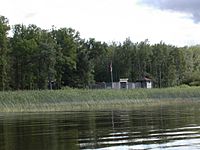Fort Saint Charles facts for kids
Quick facts for kids Fort Saint Charles |
|
|---|---|
| Magnuson's Island, Northwest Angle, Lake of the Woods County, Minnesota | |

Reconstructed version of the fort.
|
|
| Type | trading post |
| Site history | |
| Built | 1732 |
|
Fort St. Charles Archeological Site
|
|
| Lua error in Module:Location_map at line 420: attempt to index field 'wikibase' (a nil value). | |
| Nearest city | Angle Inlet, Minnesota |
|---|---|
| Area | 9.4 acres (3.8 ha) |
| Built | 1732 |
| NRHP reference No. | 83000911 |
| Added to NRHP | April 8, 1983 |
Fort Saint Charles was an important trading post built in 1732 on Lake of the Woods. It was the second outpost established by La Vérendrye. He was a French-Canadian explorer who wanted to expand trade and explore lands west of Lake Superior.
The fort was located on Magnuson's Island in the Northwest Angle of Minnesota. This area is the northernmost point in Minnesota. Today, a reconstructed version of the fort stands near the original site.
Contents
Building the Fort
In 1731, La Vérendrye arrived on the north shore of Lake Superior. He sent some of his men ahead to build Fort Saint Pierre on Rainy Lake. Then, in the summer of 1732, La Vérendrye, his eldest son Jean Baptiste de La Vérendrye, his nephew Christopher Dufrost de La Jemeraye, and a priest named Father Charles-Michel Mesaiger traveled with 50 canoes of Indigenous people. They left Fort Saint Pierre and built Fort Saint Charles.
The fort was quite large, measuring about 60 by 100 feet. It had two gates, strong 15-foot tall wooden walls (called palisades), four corner towers (bastions), and a watch tower. The buildings inside the fort had roofs made of bark. The area around the fort was great for fishing, hunting, and finding wild rice. This was very helpful because it was hard to bring food all the way from Montreal or Fort Michilimackinac.
Early Explorations
The next spring, La Vérendrye sent his son Jean Baptiste and his nephew La Jameraye to explore the Winnipeg River. They got close to a large lake but were stopped by ice.
Later, in January 1734, a group of Assiniboine people visited the fort. They brought the Europeans their first news about the Mandan people, who lived further west. Soon after, another fort, Fort Maurepas (Canada), was built.
The 1736 Attack
A sad event happened on June 6, 1736. A group of 21 people left Fort Saint Charles. This group included La Vérendrye's eldest son, Jean Baptiste, a Jesuit missionary priest named Father Jean-Pierre Aulneau, and nineteen French-Canadian voyageurs (skilled travelers and traders). They were heading to Fort Michilimackinac.
They had only traveled a few kilometers from the fort when they were attacked by Sioux warriors. Everyone in the group was killed. The Sioux were angry because they believed La Vérendrye was trading guns to their enemies, the Cree and Assiniboine people.
The attack happened on a small island, which is now called Massacre Island, Ontario. However, historians still debate its exact location. After the massacre was discovered, La Vérendrye ordered that the bodies of his son and the priest be brought back to Fort Saint Charles for burial. They were buried under the altar in the fort's chapel. The heads of the 19 voyageurs were also brought back and buried outside the fort.
The fort continued to operate for some years after this tragic event. However, it was eventually abandoned in 1749.
Finding and Rebuilding the Fort
For a long time, the exact location of Fort Saint Charles was lost. But in 1890, old letters written by Father Aulneau to his family in France were found. These letters were translated and published in 1893. They helped historians learn more about the fort and its location.
Academics at St. Boniface College in Winnipeg read these letters. They were inspired to launch expeditions to find the old fort site. By 1908, they had found the likely location of the fort and Massacre Island.
In 1912, a team of Jesuits excavated the fort site. They found artifacts that helped them identify the remains of La Vérendrye's son and Father Aulneau. These items included Aulneau's rosary and a hook from his cassock (a priest's robe), which were buried with him under the altar.
To celebrate their Golden Anniversary, the Catholic Knights of Columbus in Minnesota, along with others in Manitoba, raised money to buy the land where the fort once stood. They decided to reconstruct the fort and build a shrine to Father Aulneau. The reconstruction project began in 1949 and was finished in 1950. The reconstructed Fort Saint Charles stands on Magnuson's Island, at the mouth of Angle Inlet.
Local residents, especially Norman Carlson and Joe Risser, played a big part in rebuilding the fort. They provided important machinery and shared their knowledge of the area. Their help was crucial for the Knights of Columbus to complete the restoration.
Images for kids


